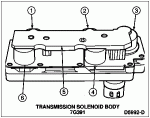yo Dennis,
WELCOME!
Can you get it scanned for Codes for free @ local parts store?
If so, post Code(s) found.
Don't buy parts yet
Is the PSOM (Speedometer) waving around while this happens?
Is the amber ABS light on while driving?
Also the Check Engine Light (CEL) comes on when the electronic engine control system is not working properly. The check engine warning indicator comes on briefly when the ignition switch lock cylinder is turned to ON, and should turn off when the engine starts. If the check engine warning indicator does not come on when the ignition switch lock cylinder is turned to ON or if it comes on while the vehicle is moving, the system is malfunctioning
If the CEL does not light up at all when starting it; then suspect that bulb is burnt-out or loose, socket was damaged by PO or shop, etc. or someone removed it.
Same for Amber ABS lamp in Instr Panel..
The anti-lock brake electronic control module monitors the electromechanical components of the system. Malfunction of the anti-lock brake system will cause the Anti-lock brake electronic control module to shut off or inhibit the system. However, normal power assisted braking remains. Malfunctions are indicated by the amber ABS warning light inside the vehicle.
The 4-wheel anti-lock brake system is self monitoring. When the key is placed in the RUN position, the anti-lock brake electronic control module will perform a preliminary self check on the anti-lock electrical system indicated by a momentary illumination of the amber ABS warning light in the instrument cluster. During vehicle operation, including normal and anti-lock braking, the anti-lock brake electronic control module monitors all electrical anti-lock functions and some hydraulic operations.
In most malfunctions of the anti-lock brake system, the amber ABS warning light will be illuminated. However, most malfunctions are recorded as a coded number in the anti-lock brake electronic control module memory and assist in pinpointing the component needing service. If system is OK, Code 16 will be present. I can give you the ez to do test for codes.\
Our module blew the microprocessors a few years ago and two yard modules were bad. No returns so I'm running without 4WABS, just like the old days.
-----------
The transmission fluid temperature sensor is located on the solenoid body assembly in the transmission sump between Converter Clutch Control (CCC) Solenoid & the Coast Clutch Solenoid.

Item Description
1 Shift Solenoid 1 (Part of 7G391)
2 Shift Solenoid 2 (Part of 7G391)
3 Electronic Pressure Control Solenoid
(Part of 7G391)
4 Coast Clutch Solenoid (Part of 7G391)
5 Transmission Fluid Temperature Sensor Location (Part of 7G391)
6 Torque Converter Clutch Solenoid
(Part of 7G391)
Once you remove the pan locate the sensor in the valve body and remove the electrical connector very carefully. The sensor is about the size of a pen cap. To remove the sensor carefully unlock the stop tab and twist it, pull down to remove it. It comes out before a full quarter turn is made. Put it back in the reverse order. When you get the sensor to come out be prepared to catch the trans fluid that follows behind it, you will get less than a quart out of it. Inspect the solenoid body the connector first; usually the root of the problem.
It is a temperature-sensitive device called a thermistor. The resistance value of the transmission fluid temperature sensor will vary with temperature change. The powertrain control module monitors voltage across the transmission fluid temperature sensor to determine the temperature of the transmission fluid. The powertrain control module uses this signal to determine whether a cold start shift schedule is necessary. The cold start shift schedule lowers shift speeds to allow for the reduced performance of cold engine operation. The powertrain control module also uses the transmission fluid temperature sensor input to adjust electronic pressure control pressure for temperature effects and inhibit torque converter clutch operation during the warm-up period.
Symptoms: Torque converter clutch and stabilized shift schedule happens too soon after a cold start. Codes P1783 indicate transmission fluid temperature exceeds 132°C (270°F), results in increased EPC pressure and torque converter clutch engagement. May flash transmission control indicator lamp.
Diagnostic Trouble Codes: P0712, P0713, P1711, P1783.
Transmission Fluid Temperature (TFT) Sensor is located on the solenoid body assembly in the transmission sump
P0712 Transmission Fluid Temperature Sensor 157°C (315°F) indicated, transmission fluid temperature sensor circuit grounded. Voltage drop across transmission fluid temperature sensor exceeds scale set for temperature of 157°C (315°F). Torque converter clutch and stabilized shift schedule may be enabled sooner after cold start. May flash TCIL. Refer to Pinpoint Test B at
http://www.diesel-dave.com/vehic/manual/stj/stj71a20.htm#b
from 96 Bronco-F-Series Workshop Manual (PARTIAL)
http://www.diesel-dave.com/vehic/manual/stj/stjleft.htm
Solenoid Pack Connector Location; "...It's on the passenger side of the transmission. You'll need to remove a small heat shield (two bolts) next to the catalytic converter, and probably clean away a TON of gunk before yanking it. Ford wasn't too bright in designing the placement of this connector. The connector has a single press-in tab latching it in place, IIRC..."
E4OD solenoid body connector seating by SeattleFSB
http://www.supermotors.net/registry/media/859616
Source: by SigEpBlue (Steve)
Solenoid Pack Connector Location; ..."I just pulled an e4od out of a 92 and that connector is VERY easy to get to if you are willing to pull your carpet. There is a very convenient access panel in the center there and it makes reaching the top and sides of the tranny very easy..."
Source: by gunterelectric226
also see;
http://www.diesel-dave.com/vehic/manual/stj/stj71a27.htm

